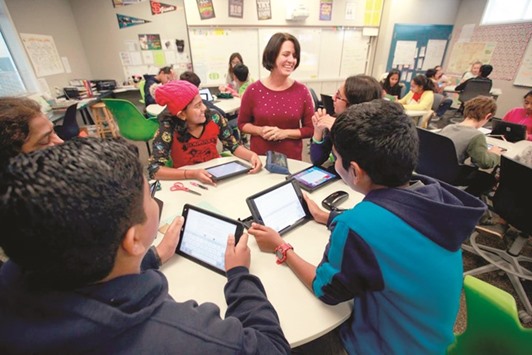In the shadow of Apple’s headquarters, an initiative requiring public middle schoolers to use iPads in class and at home has added to a battle over education in the digital age.
School district officials and many teachers say the iPads as innovative learning tools. Students, it seems, are thrilled to have them. But many parents in the affluent district question the benefit of the devices, and hundreds have signed a petition to limit their use.
They say the iPads have introduced new problems, like privacy and video-game distractions. And they resent being asked to pay hundreds of dollars for school equipment that state law says is the district’s responsibility.
“iPads are entertainment devices,” said Noemi Berry, a network engineer and mother of a seventh-grader and two other children. “They’re not designed for education, and they’re very hard to restrict. I have a 12-year-old boy who has a horrible screen-addiction problem.”
So far, the iPad proponents are winning, and soon hundreds more Cupertino middle-schoolers will be expected to use iPads linking them to their lessons, resources and the Internet.
Cupertino Union School District spokesman Jeff Bowman said putting iPads in every middle-schooler’s hands has improved the quality of their work. Language ability, behaviour and organisational skills are better, the district says, although it has no quantifiable evidence of better learning. He said principals talk to parents about how to rein in excessive video-gaming.
Apple had no comment on Cupertino’s programme, and Bowman said the company didn’t influence the district’s decision to use its product.
It’s common for school districts to provide students computers or tablets for class use. A small but growing number now require students to use those devices, or their own, for homework, too.
Few, however, specify a manufacturer such as Apple, whose products tend to cost more than devices like Chromebooks, designed for use with Google software. Bowman said they chose iPads because they considered them more durable and versatile, and to offer instructional advantages.
Cupertino’s 1-to-1 — one device per pupil — programme has cost the district at least $363,000 this school year for hardware, software, management, security and teacher training. The programme is in three middle schools and expanding to two others early next year. Bond proceeds help pay for a supply of loaner iPads for students whose parents do not provide them one.
But school officials, who started the programme three years ago at Lawson Middle School, implied that it was families’ responsibility to provide the devices, which cost $563.
In doing so, they tread carefully around state law mandating free public education and barring districts from making parents pay for required school supplies. The district hasn’t required parents to buy them. With much negotiation, some parents have arranged for their children to use laptops or even paper. But parents say they feel school and social pressure to go along with the iPad programme.
“Nobody wants their kid to be the outlier,” Berry said.
Parents like Vaishnavi Sridhar, mother of a sixth-grader, said Bragg indicated at a meeting that district-owned devices were reserved for needy students.
“A lot of families that day went back home thinking they had to buy an iPad,” Sridhar said.
Victor Leung of the American Civil Liberties Union’s Southern California branch, which sued the state over schools charging fees or requiring supplies, said that, technically, Cupertino complies with the law by offering to provide devices. But he added that, legally, districts cannot pressure students to buy equipment and supplies.
The cost is only a small part of some parents’ objections to the iPad programme. Linda Wang said her son’s grades plummeted after he delightedly received his iPad. She takes the device with her when she leaves the house, and hides it from him at night.
“We cannot control his usage at all,” Wang said. Her family, which moved into the district last year, is now considering leaving out of frustration over the iPad. “I regret so much moving to Cupertino,” she said.
For some instructors, however, the devices have transformed teaching. Andi Jackson, who teaches eighth-grade English and social studies, said iPads offer students many ways to show what they’ve learned.
“Before the iPad,” Jackson said, “there was basically one way — write an essay and turn it in.”
Peter Chu, a software executive whose daughter Ashley is a ninth-grader at Cupertino High School, sees the iPad as a phenomenal education tool that’s “creative, engaging and appropriate for this day and age.”
Ashley said the classes at Lawson in which teachers embraced the iPads were her favourites. One of her memorable assignments was creating a video explaining how palaeontology proves evolution.
“Making a story about an event lets me better remember that,” she said. Of about 180 Lawson parents who responded to a district survey last year, just under half said they valued their children’s’ iPad work. A third said it had improved their kids’ attitude toward school. The district plans to form a task force to review its educational technology use; meanwhile, it’s expanding its iPads-for-all programme to two other middle schools.
But some parents have arranged for their children to use a district-owned iPad while at school. Those devices don’t come home. An online petition is asking the Cupertino district to standardise that practice, providing iPads for students and keeping them in the classroom. It has attracted more than 650 signatures.
Lawson parent Vidya Sundaresan chose to keep her son out of the iPad programme altogether. She and her husband, both scientists, have seen no proof that iPads improve learning and worry the devices could increase risk of ergonomic problems and eye strain. Parent Carrie O’Leary shares their concern.
“I’m not against Apple products at all,” said O’Leary, whose husband is an Apple engineer. “I just want sensible policy.” — The Mercury News (San Jose, California)/TNS

IN CHARGE: Laura Plamondon teaches her class of iPad-enabled sixth graders at Lawson Middle School in Cupertino, California.
